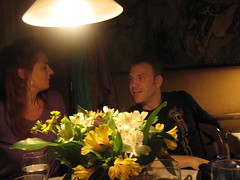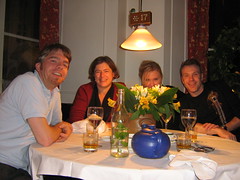The last talk I saw that I’ll report was Bernhard’s, on Algorithmic Proximity. Bernhard started off with background on the work he and Mirko have done that led up to the hybrid foam model, but his main question in this talk was to look at lower level sociality, such as in sites like Flickr, where most interactions are singular, and connections are fleeting. He is trying to understand “socio-genesis” or the process through which these low level communications crystallize into a real relationship.
In reality, individuals stand at varying social distances, or in network theory terms, where individuals are linked by paths of varying lengths which represent the probability of association. Add to this the notion of homophily; that we tend to associate with those like ourselves. (on the twitter channel for IR9 a number of people agreed that while it was true, we hated to admit it because it seemed narrow-minded).
Next, it is possible to render social interactions digitally and what will that reveal? Skipping the math… we see the importance of space somewhat reduced, and status homophily seems to be replaced by value homophily, where interest factors become more important than socio-economic factors.
Algorithmic proximity is a form of social proximity produced by the rendering of many factors in order to make recommendations about friends or matches. For example, on Facebook, the number of friends you have in common with someone may lead to a friend recommendation in “people you might know.” This is most noticeable on dating sites which aim to match people based on similarity across a range of categories, and in fact is almost essential if one is to effectively filter through all the possible matches. Bernhard went through a few other examples; Last.fm, Flickr, and Delicious, and said a bit about how on these sites, similar tagging practices might lead people to start following other users.
But what about serendipity? Is homophily a feature or a bug? If we only see people who are like us, then what? I think that’s a frightening prospect myself; I can think of a lot of interesting ideas and people I would hate to have missed, but if all my encounters were based on some kind of homophily, we would never have met. A fun counter example, the Unsuggester. This site tells you what books you would hate based on books you like (and maybe by extension, the people). I’m afraid I do judge people by what they read, sometimes….
I really need to get the whole paper because I think the math would be interesting, and also, Bernhard makes very strong but closely argued points, and a lot of the details have to be left out of such a short talk. So I’ve emailed Bernhard and if I can get more details, I’ll update this entry later because this seems important to me, thought it’s a tangent to Bernhard’s work.
If I am to figure out how people connect and stay connected, I think this could be a really important piece of the puzzle, and also suggests measurable data I could look at in order to see patterns — for example, what kind of proximity, exactly, seems most important? Are there certan values or other shared chracteristics that correlate more strongly with connection than others?
A really thought-provoking talk.


